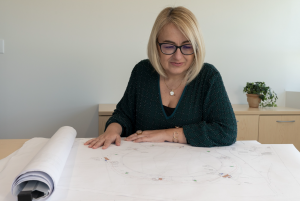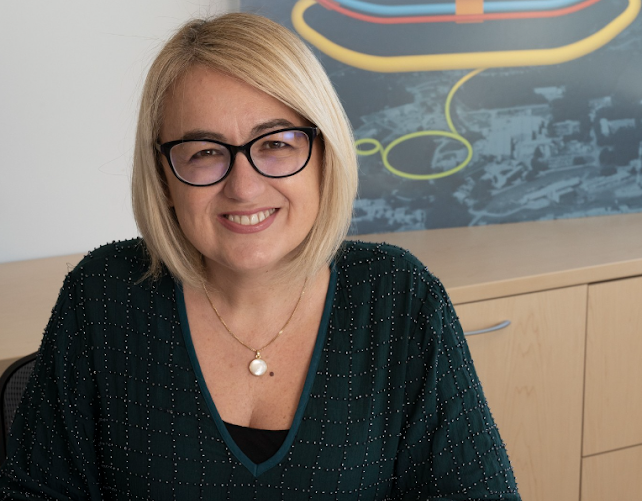BNL’s Luisella Lari embraces ‘dream job’ leading long term collider project
By Daniel Dunaief
Some day, physicists and members of the public who benefit from their discoveries may be happy that Luisella Lari had limited musical and sports talent.
Lari, who grew up in Torino, Italy, tried numerous sports and instruments, especially with her parents’ encouragement.

After gamely trying, Lari blazed her own trail, which has led her to become Project Manager and senior scientist for the Electron Ion Collider, a one-of-a-kind nuclear physics research facility at Brookhaven National Laboratory. BNL won the rights to construct the EIC, which the lab will plan and develop over the course of the next decade, from the Department of Energy in 2020.
By using a 2.4 mile circumference particle collider, physicists will collide polarized electrons into ions with polarized protons to answer a host of questions about the nature of matter. They will gather information about the basic building blocks of nuclei and how quarks and gluons, the particles inside neutrons and protons, interact dynamically through the strong force to generate the fundamental properties of these particles, such as mass and spin.
Lari, who joined the EIC effort on October 3rd, described her role, which includes numerous meetings, calls and coordinating with multinational and multi-state teams, as a “dream job.”
“I’m so excited to be a part of a project that can help the next generation of physicists,” Lari said. “It’s my turn to participate in the construction” of the cutting edge facility. BNL is coordinating with numerous other labs nationally, including the Thomas Jefferson National Accelerator in Virginia, an internationally on the project.
Amid her numerous responsibilities, Lari will ensure that effective project management systems, cost controls and project schedules are developed, documented and implemented. Core competencies of the team she is responsible for include procurement, quality and safety.
EIC applications
The EIC has numerous potential applications across a host of fields. It could lead to energy-efficient accelerators, which could lower the cost of accelerators to make and test computer chips. The EIC could also provide energetic particles that can treat caner cells and improve the design of solar cells, batteries and catalysts. The EIC may also help develop new kinds of drugs and other medical treatments.
Lari explained that she provides a review and approval of the safety evaluations performed by experts. She suggested this suits her background as she did similar work earlier in her career.

Lari has made it a priority to hire a diversified workforce of engineers, technicians and quality and safety managers who can contribute to a project that BNL will likely start constructing in 2026 and 2027.
“I am a strong supporter of building a diverse workforce at levels of the organization,” she explained in an email. “I am strongly convinced that it will add value to any work environment and in particular in a scientific community.”
Applying her experience
Lari isn’t just an administrator and a project coordinator — she is also a physicist by training.
She earned a master’s degree in nuclear engineering from Politecnico di Torino University in Italy and a PhD in physics from the Swiss Federal Institute of Technology Lausanne in Switzerland.
Early in her professional career, Lari worked at Thales Alenia Space, an aerospace company in Turin, Italy, where she collaborated for the development of her master’s thesis. She worked for two years at the company, performing tasks that included testing internal fluid supply lines for one of the International Space Station’s pressurized modules that connects the United States, European and Japanese laboratories in orbit.
She enjoyed the opportunity to work for a “really interesting project” and still routinely uses the NASA system engineering handbook.
She also worked for about a dozen years as an applied physicist and planning officer at CERN, a particle physics lab, which is on the border between France and Switzerland near Geneva.
Lari also served as a project manager and scientist for the European Spallation Source, a neutron source under construction in Sweden. She coordinated ESS Accelerator Project budgets and ran data-driven safety analyses.
Recently, Lari was a senior manager at Fermi National Accelerator in Illinois, where she coordinated international partner contributions to the Proton Improvement Plan II, which upgraded the accelerator complex.
A need to know
When Lari was in middle school, the Chernobyl nuclear power plant melted down. As a school assignment, she had to explain what happened. At that point, she said she understood nothing, which motivated her to want to become a nuclear engineer.
She was “fascinated by nuclear energy.” When she worked at CERN, she had not been studied much about accelerator physics. She attended meetings where sophisticated discussions physics took place and was driven to learn the material.
“All my life, which started when I was a child, I wanted to understand the world around me,” she said. Her work in project management for scientific projects is also her passion, she said. “My mother would say to me when I was younger that I should choose my job in a way that I would do something I like, because I will spend half my life doing it.”
In addition to committing to understanding the physics and helping other scientists pursue their curiosity, Lari said she appreciates the opportunity to collaborate.
While Lari never became proficient in music or athletics, she enjoys dancing and is looking forward to attending Broadway musicals in New York.
She has hosted her parents at each of the places where she has worked, broadening their horizons.
As for her work, Lari recalls being impressed by the ability of the managers at the LHC to summarize complex work in a few pages and to make big picture decisions that affected so many other scientists. She became impressed and inspired “by the power of the project administrator approach,” she said. She also appreciates the opportunities to interact with experts in several fields, which gives her the chance to “better understand and learn.”







